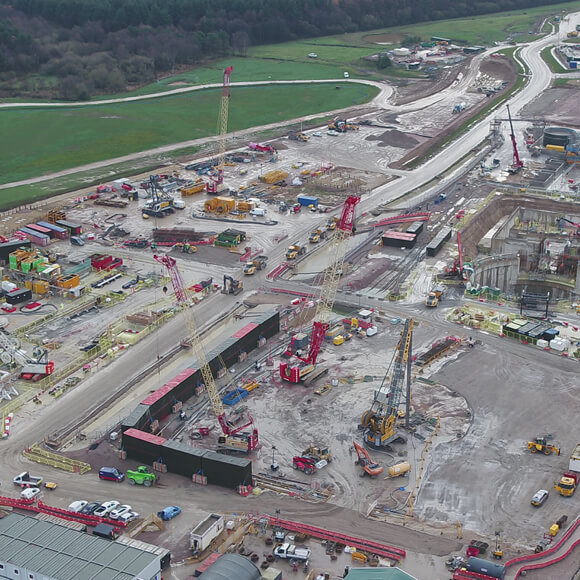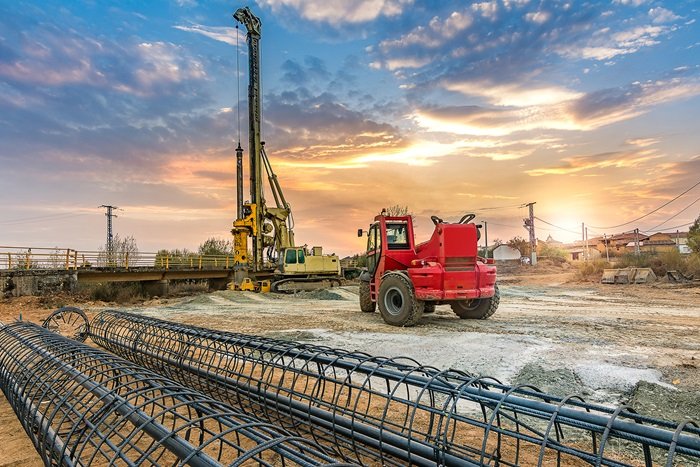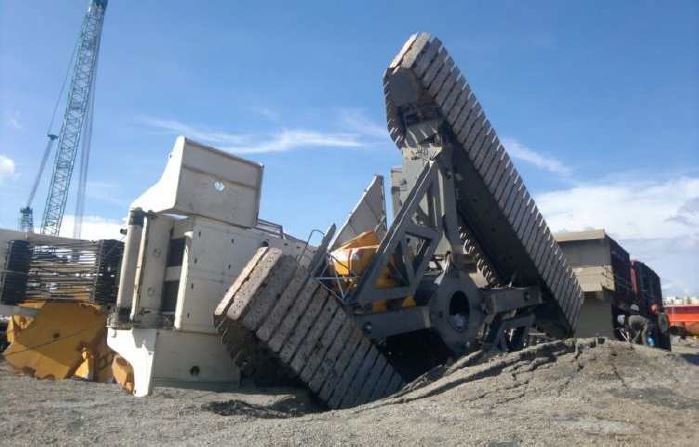Piling in Construction: Types of Pile Foundation & Piling Methods
Many different types of pile foundation are used in construction, but they all have one important function: to transfer loads from a structure or building into the ground.
Some pile foundation types are named after the technique used – bored pile foundations, for instance, which require the boring of large holes into the ground. Other piling methods are categorised by their intended purposes. Friction piles are an often-cited example of this, as they are designed to transfer load to the surrounding soil by friction.
In this guide, we’ll first explore what piling is and where it came from, then consider the different types of pile foundation, the methods of constructing piles, the installation of piles and finally the role of safe working platforms in supporting piling rigs.
Use the links below to jump to the section you’re most interested in:
- What is piling in construction?
- What are pile foundations?
- What are the types of piling?
- Types of pile foundation
- Where did piling come from?
- Methods of constructing piles
- Piling in bridge construction
- Safe working platforms
- How Tensar can help
What is piling in construction?
Piling is the process of driving or boring pile foundations into the ground beneath a building that is under construction. These piles transfer loads from the structure to the ground, helping to support it. Pile foundations are often used where the ground is too weak to underpin the structure.
What are pile foundations?
Pile foundations are long, thin elements generally made of steel or reinforced concrete. They transfer the load through weak, compressible material onto more compact, less compressible stiffer soil or rock at greater depth. The deep insertion of these elements ensures a sturdy base on which the construction project can take place.
It’s important to note that the pile foundation and pile are two different things, yet they work in conjunction to ensure that piling can support strong loads. A pile foundation is typically defined as the series of columns that act as the base for structures, whereas the pile itself is the column or cylinder that aids in transferring the load to the lower subsoil.
Read on to learn more about the different types of piling and the methods of constructing piles.
What are the types of piling?
The two main types of piling are end-bearing and friction piles:
- End-bearing piles transmit loads directly to a deeper strong soil or rock layer some way below the surface.
- Friction piles transfer load by friction between the surrounding soil and the surface of the pile over its full length.
As we’ve seen already, these piling techniques are defined by their purpose – either to pass on load to an endpoint below the surface, or otherwise to create friction with the soil along the length of the pile.
In the next section, we’ll look at the main different types of pile foundation. Each of these types can make use of either end-bearing or friction piles – or a combination of the two – depending on the ground conditions and the requirements of the project.
Find out how you can reduce platform thickness on your piling mat project with our T-Value approach.
Download Guide
Types of pile foundation
There are many different types of pile foundations and several subcategories. Each type of pile foundation is designed to meet specific ground conditions, load requirements and project needs.
The main types of pile foundations include:
- Driven piles
- Bored piles
- Rotary bored piling
- Continuous Flight Auger (CFA) piles
- Driven and cast-in-situ piles
- Aggregate piles
- Sheet piles
- Timber piles
The construction of each type varies but they are all united by the fact that they must be bored or driven into the ground. Read on to learn about these different pile foundation types, or use the links above to navigate to a particular type.
Driven piles
Driven piles are the classic type of pile foundation. They can be constructed with timber, a technique centuries old and still used across the globe. In the UK, timber piling is used mainly for coastal works, sea defence and jetties. Another option is precast concrete piles, reinforced to withstand driving stresses, they are usually pre-pressed with a square or octagonal section. Lastly, there are steel piles of tubular, box, or H section. Interlocking steel sheet piles are also widely used, predominantly for wall construction.
With each of these materials, the piles are driven into the soil, pushing an equal volume of soil sideways and compacting a zone around the pile, increasing its bearing capacity. For this increase in soil strength to take place, the pore water pressures must dissipate by rapid drainage. This type of piling is not suitable for saturated or silty soils as they drain slowly and can not be compacted in the same way.
Bored piles
Bored piles, also known as replacement piles or drilled piles, are constructed when large holes are drilled in the ground and filled with concrete. Bored piles are very effective as they transfer the load above ground to the deep rock and soil layers below with minimal settlement, which is ideal for supporting structures such as bridges and flood protection.
For some bored piles, the bottom of the hole is widened or under-reamed, creating a bulb at the end. A steel reinforcement cage is lowered into the hole before the concrete is placed or dropped in after the concrete has been poured.
Bored pile construction methods can vary depending on ground conditions. Within the category of bored pile foundations, the two commonly used subtypes are rotary bored piling and Continuous Flight Auger (CFA) piling.
Rotary bored piling
Rotary bored piling is used in cases where there are significant obstructions in the ground. A temporary casing is installed by the piling rig to provide support. ‘Pile arisings’ (ground and rock removed via boring process) are removed from inside the casing, then a steel reinforcement cage is installed. At this point, the hole is filled with concrete and the casing is removed.
Continuous Flight Auger (CFA) piles
Continuous Flight Auger (CFA) piling does not require the use of temporary casing – it is the most versatile, effective and commonly used type of bored pile foundation in the UK. Once the hole has been bored, concrete is pumped in, then a steel reinforcement cage is inserted.
.jpg)
Rotary bored piling rig
Bored piles vs driven piles
As stated above, driven piles are a classic form of piling technique where a pile is driven into the soil, increasing its bearing capacity. Whereas a bored pile is constructed via drilling holes in the ground and filling with concrete.
The main difference between these two types of piles are that driven piles are formed off site and put in place on-site, whilst bored piles are cast in concrete on-site. Driven piles have the advantage of being rapid to build and use, however they create lots of vibrations, so aren’t suitable at compact sites. Bored piles are favoured as they don’t create this disturbance in soils, have higher bearing capacities and avoid seasonal disturbances such as frost penetration.
Driven and cast in-situ piles
Driven and cast in-situ piles combine the advantages of both piling construction methods.
One option is a permanent casing type, where a tubular casing (or shell) made from reinforced, corrugated thin steel is driven into the ground using a mandrel inserted into the casing. The mandrel is then withdrawn, leaving the casing in place. Finally, concrete is poured into the casing, forming a steel/concrete composite pile.
Another version of this type of pile foundation uses a temporary casing. Known as the Franki type, this is where a steel reinforcement cage is lowered into the casing, which is then withdrawn as dry concrete mix is being placed. The concrete is compacted, and some is forced out of the bottom of the casing, forming an enlarged bulb which increases the pile bearing capacity.
Aggregate piles
Aggregate piles, or stone columns, mean that compacted aggregate is used to form the pile, rather than concrete. This type of pile foundations works using the following process:
- A casing is inserted as the hole is bored, and aggregate is dropped into it in layers which are then vibrated or compacted as the casing is withdrawn.
- The aggregate is forced sideways into the surrounding soil to improve bearing capacity.
- Vibro-type aggregate piles create densely compacted columns made from gravel – or a similar material – using a vibrating casing. The displacement process densifies the surrounding granular soils.
- With Geopier-type aggregate piles, aggregate is rammed into a casing, forcing it out the bottom to create a dense bulb. This is repeated in stages as the casing is withdrawn, densifying, and improving the strength of the surrounding soil.

Sheet piles
Sheet piles are a type of driven pile and they are installed next to each other with interlocking mechanisms to form a wall-like structure. They are widely used in the UK for both temporary and permanent structures where soil or water retention is required. Common applications include retaining walls, coastal protection and underground structures.
In some cases they can be reused, making them a cost-effective and sustainable option. They are often installed using vibratory hammers or impact hammers if the soil is dense and ground conditions are hard.
Timber piles
As mentioned previously, timber piles were the earliest form of piling to be used. They are an environmentally-friendly alternative to other piling materials and can be a cost-effective option. However, their composition makes them vulnerable to rot and decay which can lead to higher maintenance costs in the future and their low bearing capacity makes them unsuitable for heavy structures.
Timber piles are commonly used in maritime construction and are widely utilised for structures such as groynes, piers, jetties and other sea defences.
Where did piling come from?
As with many modern techniques, our high-tech piling systems today grew out of a clear need, hundreds and even thousands of years ago, that still exists today. Some of the first recorded examples of piling include river dwellers in Switzerland 6000 years ago, building structures on piled foundations to defend against flooding and attack, by elevating their dwellings. The Romans – inevitably – led the way with piles for shore works in Europe, and in the UK, there is proof that they used timber piles driven into the riverbed for bridges in London and Corbridge, over 2000 years ago.
In early civilisations, cities and towns wanted to build close to rivers for communication and protection, so the swampy soil needed to be fortified and strengthened with something – which is how and why piling was born. Timber piles were driven into the ground by hand, or holes were dug and filled with sand and stones. In more modern times, the ever-increasing need for buildings and infrastructure has forced authorities and development agencies to exploit land with poor soil characteristics. Piling is – as it always was – vital in our modern-day construction industry.
Pile construction and installation
Most piling rigs are track mounted and are specialist plant items, built to install one type of pile. Driven piles are hammered, jacked or vibrated into the ground using a percussion hammer, hydraulic driver or rams (typically used for sheet piles), or diesel-powered vibratory drivers used to reduce surrounding ground resistance and allow the pile to slide into the ground.
Bored piles use a continuous auger, very similar to a very large drill bit, between 300mm and 900mm diameter. For large diameter piles, a circular bit up to 1200mm diameter is used. Rigs are large with weights ranging up to 180 tonnes.
Piling in bridge construction
Piles are often installed alongside bridge abutments to provide the strong foundational support to withstand the weight of the structure above. For bridges constructed on land, the process is very similar to traditional forms of piling.
Constructing a bridge over a body of water can present some unique challenges. For piles to be installed, a watertight enclosure called a cofferdam is constructed. The water is then pumped out to allow for the construction of the piles.
Safe working platforms
Piling rigs are produced in a range of sizes, depending on the type and depth of pile required. Rigs are required to move about and position accurately for each pile location. The area on which the rigs operate is known as the Piling platform. Platforms are usually formed by compacting a layer of coarse, granular fill, to a specified depth. The appropriate fill might be brought on to site or crushed, demolition rubble from site can be used for brownfield developments.
The piling platform is required to distribute the load from the tracks and avoid bearing failure, minimising settlement to ensure safe operation of the rig. Working platforms must be properly designed by a qualified engineer, using soils data and piling rig loading for the specific site. Platforms need to be properly constructed and regularly inspected and maintained by the contractor.
The Federation of Piling Specialists (FPS) state that one third of all Dangerous Occurrences reported by their members are related to piling platforms. They warn "every Dangerous Occurrence and every 'near miss', involving the platform is a potential fatality". The Principal contractor for the site is responsible for the design and construction of the piling platform and they will often contract design to a professional engineer.
Crane toppled over demonstrating the importance of safety
Photo credit: www.heavyliftnews.com
The FPS operates a certification system for working platforms and the Principal Contractor is required to sign the certificate confirming the platform has been properly designed and correctly constructed in accordance with the design, and that it will be regularly inspected and maintained. A guide to good practice, BRE Report BR470 was published in 2004 and subsequently reviewed to consider designs incorporating geosynthetics.
Tensar has developed its T-Value Method for the design of working platforms that delivers safe economic designs. Tensar International also offers design software incorporating the T-Value method for use by engineers designing piling platforms, as well as offering a full piling platform design service to contractors.





.png?width=400&height=400&ext=.png)